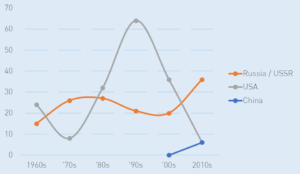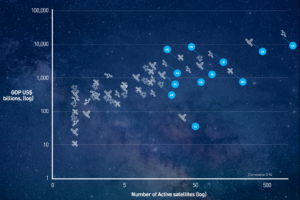
“Ground control to Major Tom”
Conquering space is a perennial aspiration of humans. From Daedalus and Icarus in the Greek mythology to “From the Earth to the Moon” and its sequel “Around the Moon” by Jules Verne in the mid-19th century, the narrative was always there: Capturing higher and higher distances from the earth and ultimately reaching to the moon. Yet it took about another century to make Jules Verne’s novel, a reality.
This reality was accomplished in the midst of the ‘cold war’ between the East and the West. The Soviet Union was successful in launching Sputnik 1, the first satellite, into orbit in 1957 and the first human in space, Yuri Gagarin, in April 1961. In fact, to commemorate this historic event, the UN has declared April 12, the International Day of Human Space Flight.
In May 1961, shortly after Gagarin’s feat, President John F. Kennedy declared a clear goal and time frame in his address to the Congress: “…before this decade is out, of landing a man on the moon and returning him safely to the earth.” In July of 1969, before the end of the decade, and a half-century ago, this mission was accomplished: Neil Armstrong was the first human to walk, on the surface of the moon and safely return to the earth.
Since then, manned space flight continues to be a rare event. Figure 1 captures the number of launches between the 1960s and 2010s. They were performed by three countries, the USA, the Soviet Union and subsequently Russia, and more recently, China; and only 561 people have participated in these flights. In fact, the USA has not had manned space flight capability since the grounding of the space shuttle fleet back in 2011, but now plans to go back to the moon in 2024 and on to Mars in 2033.

It is not surprising that the space launches were driven initially by countries; the (public) investments required were enormous. The Apollo project that took the first humans to the moon, required US$ 25.4 billion (US$ 163 billion adjusted to today’s prices) for the period 1961-1972.
Yet, this is not the standard anymore. Placing satellites into space is a common and frequent undertaking. In February for instance, there were 8 launches, carrying 22 separate payloads including Elon Musk’s car. Figure 2 depicts the current active satellites by country. As it can be seen, most major countries have some space presence, even if the actual launch capabilities are still dominated by a handful of countries.

Given the high amount of investment required, it is expected that the relationship between GDP and the number of active satellites is correlated across countries. Figure 3 depicts this relationship. The vertical axis provides the logarithm of a county’s GDP while the horizontal axis depicts the logarithm of the active satellites of a country. The correlation coefficient is equal to 0.94, reflecting the strong positive relation.

Interestingly, we do not find an equally strong relationship with the competitiveness rankings of the countries. In fact, the correlation coefficient of the active satellites with the competitiveness ranking is 0.27 while the correlation with the digital competitiveness ranking is 0.24.
One reason may be the range of satellite usage which is not taken into consideration in the above figure. There are four main ownerships of satellites: government, civil (largely universities), military and commercial. And within each of these ownership groups, there several broad categories of use such as communications, meteorological, science and GPS. To place is in perspective, there exist student-project satellites weighing one kilo and there exists the Hubble telescope weighing 11 tons and costing over US$ 1.5 billion.
The graph on the left of Figure 4 provides the number and percent of satellite ownership. For example, commercial satellites, those owned by companies that is, make up 48% of active satellites, while government satellites make up 25%. The graph on the right of Figure 4 offers a breakdown by number and shares of the commercial satellites use. Thus, 52% of the commercial satellites are used for communication purposes.

The increasing significance of commercial satellites emphasizes that there are private investments currently underway. This denotes a “crowding-in” effect where the private sector followed the investments made by the public sector. In effect, the number of commercial satellites is highly correlated with both Business Research spending in US$ millions (correlation coefficient equal to 0.88) and Exports of Commercial Services in US$ billions (correlation coefficient equal to 0.80). This latter correlation reminds us that ownership of a satellite is a strategic decision. And very large companies that rely heavily on satellite use may buy data or rent access from others. A quick search indicates that Google doesn’t currently own any satellites, but instead buys data from other sources including its ex-subsidiary Terra Bella.
After launching a car into space in February, Elon Musk’s SpaceX company followed up in March by successfully completed a test flight for its Crew Dragon manned spacecraft. This successful test reached the International Space Station – boldly going where no enterprise has gone before. With Boeing planning a similar test later this year, manned space flight will soon no longer be in the hands of a few governments, and perhaps in the next few years commercial space flight will be just as common and as varied as commercial satellites.
In my opinion, the history of conquering space points towards an additional dimension: areas where the public and private sectors will be able to collaborate and enhance the strengths of each other to address future challenges. This is more important because for the ‘big’ problems we are facing, such as sustainability and climate change, the public and private sectors need to co-create the solutions.
PS: I could not resist using a verse from the 1969 song “Space Oddity” by David Bowie as part of the title of this Criterion of the Month. I was surprised to find out that BBC played this song on July 20 when Neil Armstrong landed on the lunar surface. It is good that opposite to what happened in the song, the crew of Apollo 11 returned safely in the earth.
Research Information & Knowledge Hub for additional information on IMD publications
Research Information & Knowledge Hub for additional information on IMD publications
Research Information & Knowledge Hub for additional information on IMD publications
Research Information & Knowledge Hub for additional information on IMD publications
Published by International Institute for Management Development ©2024
Research Information & Knowledge Hub for additional information on IMD publications
in I by IMD Magazine June 2024, no. 14, pp. 48-53
Research Information & Knowledge Hub for additional information on IMD publications
Research Information & Knowledge Hub for additional information on IMD publications
in I by IMD 13 June 2024
Research Information & Knowledge Hub for additional information on IMD publications
in I by IMD 6 June 2024
Research Information & Knowledge Hub for additional information on IMD publications
Research Information & Knowledge Hub for additional information on IMD publications
Research Information & Knowledge Hub for additional information on IMD publications









